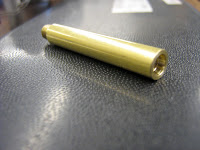The final week is finally here. These last three days have been a flurry of flute work. After a weekend of padding, there was not that much left to do. So here it is. First off, I had to pad the trill keys and the upper C key. These pads are very much like the pads on a clarinet. They are floated in with glue and leveled. After all of the pads are leveled, we bake a seat in the pads using a bit of water and a mail-box oven.
While the pads were setting, I turned my attention to the head joint. There was a bit of silver plate peeling from the inside, so before I replaced the head cork, I quickly buffed the inside of the tube with black rouge on the lathe. We use the lathe because the speeds on the buffing machine or our bench motors are much too high and may damage the plating on the inside. So at a low speed, we use a rag and a dowel to spin it clean.
After it was all cleaned up, I installed the head cork. Using a sleeve, I cut the cork down to 1 inch in length to provide a better sound for the nickle silver head joint. I then sanded a slight taper into the cork to get the proper fit. Finally, I sealed the cork with paraffin wax and installed it. The crown was tightened up and the head joint is almost ready to go.
The pads are still setting up at this point, so I began to work on fitting the tenons. Normally, we would do this before padding, but with only one head joint expander and 22 students, I figured I would wait for a bit. The sockets and tenons were rounded out and the tenons were expanded slightly to fit snug. After that, the pads were set and we move to corking.
Corking and regulating the flute is slightly different than the clarinet. Because there is no lost motion on the flute, there is a specific order in which you must regulate then vent the stacks. But it all involves sanding. Protecting the body with blue tape, I used 320 grit sand paper to shape the corks and set the venting of each key. Fun stuff.
Finally, the flute is finished. I gave it a quick polish with silver cloth and play tested it. There was one issue with the G# key getting bent which caused it not to close properly. Totally my fault, but an easy enough fix. So after bending it back, then fixing the issue that caused me to bend it in the first place, then re-straightening the hinge rod and key because I bent it while bending it to fix it... the flute was re-play tested. Having passed this time, the case was cleaned and the paperwork filled out. Having fulfilled my duties here for the year, I make my way back to Canada in the morning for a 3 week vacation. Merry Christmas to all and I will see you in the new year.
While the pads were setting, I turned my attention to the head joint. There was a bit of silver plate peeling from the inside, so before I replaced the head cork, I quickly buffed the inside of the tube with black rouge on the lathe. We use the lathe because the speeds on the buffing machine or our bench motors are much too high and may damage the plating on the inside. So at a low speed, we use a rag and a dowel to spin it clean.
After it was all cleaned up, I installed the head cork. Using a sleeve, I cut the cork down to 1 inch in length to provide a better sound for the nickle silver head joint. I then sanded a slight taper into the cork to get the proper fit. Finally, I sealed the cork with paraffin wax and installed it. The crown was tightened up and the head joint is almost ready to go.
The pads are still setting up at this point, so I began to work on fitting the tenons. Normally, we would do this before padding, but with only one head joint expander and 22 students, I figured I would wait for a bit. The sockets and tenons were rounded out and the tenons were expanded slightly to fit snug. After that, the pads were set and we move to corking.
Corking and regulating the flute is slightly different than the clarinet. Because there is no lost motion on the flute, there is a specific order in which you must regulate then vent the stacks. But it all involves sanding. Protecting the body with blue tape, I used 320 grit sand paper to shape the corks and set the venting of each key. Fun stuff.
Finally, the flute is finished. I gave it a quick polish with silver cloth and play tested it. There was one issue with the G# key getting bent which caused it not to close properly. Totally my fault, but an easy enough fix. So after bending it back, then fixing the issue that caused me to bend it in the first place, then re-straightening the hinge rod and key because I bent it while bending it to fix it... the flute was re-play tested. Having passed this time, the case was cleaned and the paperwork filled out. Having fulfilled my duties here for the year, I make my way back to Canada in the morning for a 3 week vacation. Merry Christmas to all and I will see you in the new year.
























































